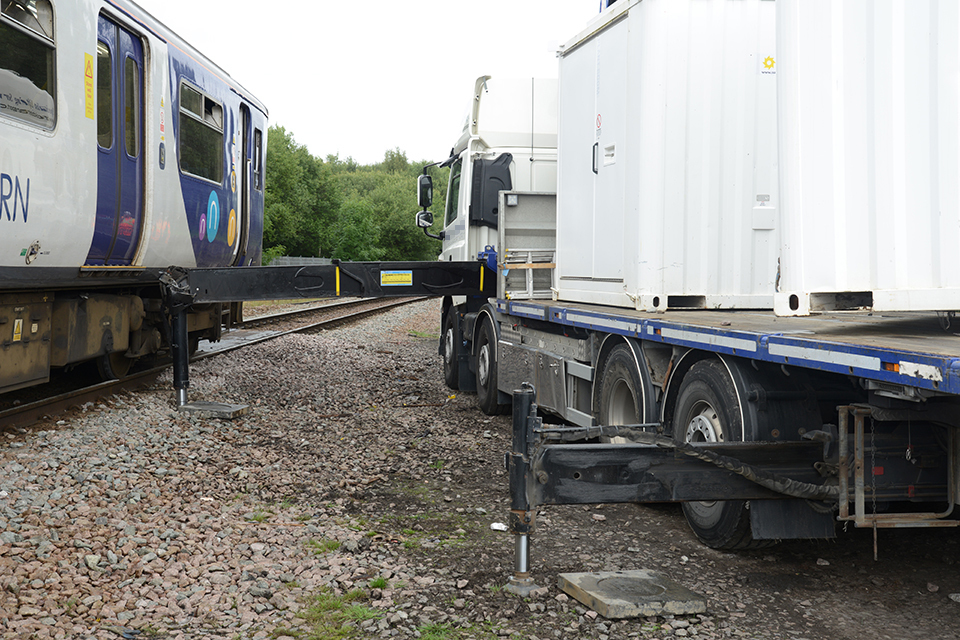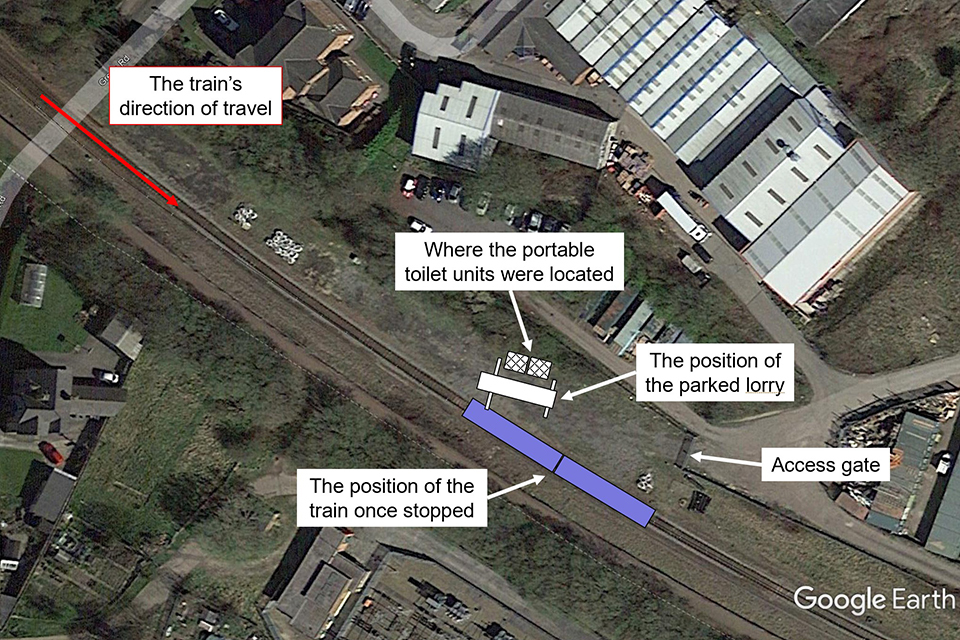Collision between a train and lorry stabiliser leg at Penistone, South Yorkshire, 27 August 2021
Published 7 December 2021
1. Important safety messages
This accident demonstrates the importance of:
-
organisations which work within the railway boundary following their procedures so that visitors are appropriately managed and supervised when they are lineside, particularly where sites are being set up or shut down, or on other occasions when supervisory staff are less likely to be present
-
organisations having a clear understanding of the requirements when work is taking place within the railway boundary that involves road vehicles, so that they can ensure that an appropriate safe system of work, and staff with the required competencies, are in place.
2. Summary of the accident
At 08:48 hrs, train reporting number 2B07, the 08:12 hrs Northern service from Huddersfield to Sheffield, was travelling at 20 mph (32 km/h) when it struck the stabiliser leg of a lorry that was parked next to the track. The lorry’s stabiliser legs had been deployed as its crane was being used to lift portable toilet units onto its flatbed. The accident occurred about 0.3 miles (0.5 km) to the south-east of Penistone station, on the section of line between Huddersfield and Barnsley.
The train had been accelerating after departing from Penistone station, and had reached 27 mph (43 km/h) when the lorry came into view. The driver saw a person near to the lorry and sounded the train’s horn to give a warning. Although the driver saw the person and lorry, the stabiliser legs were not clearly visible, and the driver continued accelerating. As the train got closer, the driver then noticed one of the stabiliser legs was very close to the track, so he applied the train’s brakes. The train struck the lorry five seconds later. The train crew and 25 passengers on board the train were unhurt by the collision. The lorry’s stabiliser leg was damaged and there was also some damage to the front and side of the train.
After the train came to a stop, the driver made an emergency call to report the accident. The train was later moved to Barnsley, from where the passengers were able to continue their journeys.

The position of the train and lorry after the accident (image courtesy of British Transport Police)
3. Cause of the accident
The accident happened at a site within the railway boundary that had been used by the Central Rail Systems Alliance (CRSA) as a base for track renewal work. CRSA is an alliance between Network Rail and a consortium of three contractors, and is responsible for the development, design and delivery of track renewals under a ten-year contract. The track renewal work, using the site at Penistone, had taken place from Friday 6 August to Monday 9 August.
CRSA was responsible for managing the site at Penistone. It used a contractor to provide two portable toilet units that were delivered to the site on 30 June. After the completion of the work, CRSA began to clear the site and arranged for the portable toilet units to be collected by the contractor on 27 August. The contractor subcontracted a haulage company to collect the units.
The haulage company’s lorry driver parked near to the access gate for the site at 08:32 hrs on 27 August. He met a member of CRSA staff who had been asked to let the lorry into the site. Once they had confirmed the lorry was in the right place, the driver drove into the site through the open gates and parked it in a position to lift the portable toilet units onto the lorry’s flatbed. He then deployed the stabiliser legs in readiness to use the lorry’s crane. The lorry driver had already loaded the first unit onto the lorry and was just lowering the second one when the train approached and struck the lorry’s front, nearside stabiliser leg.

Site layout showing where the lorry was parked within the site
The lorry driver did not consider how close the stabiliser leg was to the nearest running line when he positioned the lorry and set it up for the lifting operation. Measurements and witness marks on the ground indicate the base of the stabiliser leg was at the end of the sleepers, about 0.5 metres from the nearest rail. The lorry driver had no experience of working next to an open railway line and thought that no trains were running because he had been let straight into the site by the CRSA member of staff. The lorry driver had not confirmed his understanding that no trains were running.
The member of CRSA staff was a key holder for the access gate to the site. He had been asked on the previous evening, to go to the site at 07:45 hrs and was only told to open the gate and allow the lorry into the site to collect the portable toilet units. He was standing next to the access gate when the train approached and had not realised that the stabiliser leg was too close to the nearest running line.
If work is taking place within the railway boundary fence, but is more than three metres from the nearest running line, and can be seen by the driver of an approaching train, then the railway Rule Book, GE/RT8000, defines this as being on the ‘lineside’ (the definition of lineside has been simplified in the next version of the Rule Book, which is due to be published in December 2021, by removing the condition of being visible to the driver). If work is taking place closer than three metres from the nearest running line, then the Rule Book defines this as being ‘on or near the line’.

Rule Book definitions of lineside and on or near the line
The position where the lorry had been parked to lift the units meant that it was on or near the line. The Rule Book requires a controller of site safety (COSS) to be present before a road vehicle can go on or near the line, but, while the CRSA member of staff held a personal track safety competency (PTS), no one who held the COSS competency was present on this occasion. The Rule Book also states that no part of a road vehicle should be allowed within two metres of any line on which a train might approach. In this case, however, one of the lorry’s stabiliser legs was much closer than two metres and was in fact foul of the nearest running line.
The contractor who provided the portable toilet units had a generic method statement and lifting plan for collecting the units. The method statement included a hazard analysis section, with a checklist of hazards to consider. It also included a risk assessment for the identified hazards, with each hazard given a risk score (its likelihood multiplied by its severity) and a control measure to reduce the risk. ‘Railways’ was included as a possible entry in the hazard checklist, but it had not been selected for the work on 27 August. This meant that the contractor did not carry out a risk assessment for working near to a railway line. The method statement made no other mention of working near to railways and did not specify what levels of supervision, experience or competence would be required.
CRSA had adopted a Balfour Beatty procedure for managing visitors to its sites, as Balfour Beatty was one of the contractors in the alliance. The purpose of the procedure was to define and monitor the health and safety controls associated with visitors to CRSA offices, depots and facilities and to ensure that those accessing these sites were not placed at risk. It stated that all visitors must sign in, wear appropriate PPE, be given a visitor’s induction, and always be accompanied by a fully inducted person. The procedure also included a section for visitors required to go on or near the line. It required these visitors to hold the PTS competency or to complete a medical self-assessment and obtain a track visitor permit (TVP). The procedure then required a COSS to validate the visitor’s PTS or TVP, and set up a safe system of work, in accordance with the Rule Book, to meet the needs of the visit. None of this happened when the lorry driver arrived to collect the portable toilet units on 27 August.
4. Previous similar occurrences
RAIB report 16/2019 describes an incident that happened on 13 March 2019, when a passenger train passed over Mucking automatic half barrier level crossing a few seconds after a partially loaded concrete delivery lorry had reversed clear as part of a manoeuvre to enter an adjacent Network Rail construction site. The report highlighted that effective planning, management support and supervision is essential for all construction activity on or near the railway, including short duration works on isolated and/or small sites.
RAIB report 36/2007 describes how, on 5 February 2007, a bridge inspection unit mounted on a lorry was deployed from a motorway bridge, over the railway between Maidstone Barracks and Aylesford stations. The gantry on the bridge inspection unit was struck by a passenger train, causing significant damage and minor injuries to the train driver and a passenger. The report explains that neither the contractor or subcontractor responsible for the lorry had prepared a method statement, no site or task briefings had taken place, no clear understanding was reached about the positioning and use of the lorry, and no one sought confirmation from a COSS that it was safe to work on or near the line. RAIB recommended that the contractor review the briefing process for its staff and contractors to ensure that they were adequately aware of any nearby railway. RAIB also recommended that the contractor review its systems to ensure site supervisor competence is effective.

